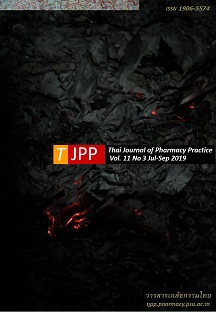ผลของการจัดการปัญหาการใช้ผลิตภัณฑ์สุขภาพปลอมปนสเตียรอยด์ในชุมชน ในเขตโรงพยาบาลส่งเสริมสุขภาพตำบลขุนลาน อำเภอดอกคำใต้ จังหวัดพะเยา
Main Article Content
บทคัดย่อ
วัตถุประสงค์: เพื่อศึกษาผลของการแก้ไขปัญหาการใช้ผลิตภัณฑ์สุขภาพปลอมปนสเตียรอยด์ (steroid adulterated health products หรือ SAHP) ในชุมชนที่ตั้งอยู่ในเขตรับผิดชอบของโรงพยาบาลส่งเสริมสุขภาพตำบล (รพสต.) ขุนลาน อำเภอดอกคำใต้ จังหวัดพะเยา วิธีการวิจัย: การศึกษานี้เป็นการวิจัยเชิงปฏิบัติการในการจัดการปัญหาการใช้ SAHP ในชุมชน การศึกษาแบ่งเป็น 3 ระยะ ระยะที่ 1 เป็นการสำรวจครัวเรือนในชุมชนก่อนดำเนินการ ระยะที่ 2 เป็นการดำเนินการแก้ไขปัญหา โดยแบ่งเป็นการรักษาผู้ป่วยที่ได้รับผลข้างเคียงจาก SAHP การจัดการแหล่งกระจายยาในชุมชน การสร้างระบบคัดกรองผู้ป่วยที่ได้รับผลข้างเคียงจากสเตียรอยด์โดยบูรณาการกับการเยี่ยมบ้าน การสร้างกระบวนการการค้นหาและตรวจสอบเบื้องต้นเมื่อพบผลิตภัณฑ์ที่เสี่ยงต่อการปลอมปนสเตียรอยด์ การสื่อสารความเสี่ยงโดยอาสาสมัครสาธารณสุขประจำหมู่บ้าน (อสม.) ระยะที่ 3 เป็นการประเมินผลการดำเนินการแก้ไขปัญหาในชุมชน ผลการศึกษา: หลังการดำเนินงานแก้ไขปัญหา การใช้ SAHP ลดลงอย่างมีนัยสำคัญทางสถิติ จาก 12 รายการในช่วงก่อนเริ่มโครงการเป็น 2 รายการ ผู้ป่วยที่มีอาการไม่พึงประสงค์จากการใช้ SAHP 12 ราย มีอาการแสดงได้แก่ หน้าอูม 10 คน ความดันโลหิตสูง 8 คน ภาวะอ้วน 8 คน มีโหนกที่หลัง 5 คน มีจ้ำเลือดตามตัว 4 คน และมีอาการผิดปกติของทางเดินอาหาร เช่น อาการปวดท้อง แสบท้อง จำนวน 3 คน ผู้ป่วยจำนวน 11 คน สมัครใจเลิกใช้ SAHP โดยให้แพทย์ตรวจอาการก่อนการหยุดยา และอยู่ในการดูแลของพยาบาลประจำ รพ.สต. โดยไม่เกิดภาวะ adrenal crisis ส่วนอีก 1 รายยังมีการใช้ SAHP แต่ลดปริมาณการใช้ลง หลังดำเนินงานตามโครงการได้มีการตรวจร่างกายผู้ป่วยอีกครั้ง พบว่า น้ำหนักของผู้ป่วยลดลงอย่างมีนัยสำคัญทางสถิติ จากค่าเฉลี่ย 63.75±5.50 กก. เป็น 59.42±6.17 กก. และระดับความดันโลหิตบนของผู้ป่วยลดลงจากก่อนเริ่มโครงการอย่างมีนัยสำคัญทางสถิติ คือจาก 155.50±13.83 มม.ปรอท เป็น 129.17±16.35 มม.ปรอท หลังจากผู้ป่วยหยุดใช้ผลิตภัณฑ์ ผู้ป่วยมีอาการแสดงของภาวะ Cushing ลดลง ไม่พบอาการจุดจ้ำเลือดตามตัว และพบว่าอาการต่าง ๆ ลดลงจากช่วงก่อนเริ่มโครงการ หลังการแทรกแซง ชุมชนมีการตื่นตัวในปัญหาการใช้ SAHP โดยเกิดกระบวนการการเฝ้าระวังยาที่ไม่ปลอดภัยและการคัดกรองผู้ป่วย Cushing โดย อสม. การสร้างมาตรการชุมชนโดยใช้เครือข่ายผู้นำชุมชน วัด และ อสม.ในการตรวจสอบและเฝ้าระวังการจำหน่ายยาโดยใช้รถเร่หรือผู้แทนยา การสื่อสารข้อมูลระหว่างกันอย่างรวดเร็วโดยผ่าน line ทำให้ SAHP ในพื้นที่ลดลง สรุป: การดำเนินงานแก้ไขปัญหาการใช้ SAHP ที่มีประสิทธิภาพ ต้องอาศัยความร่วมมือจากชุมชนอย่างต่อเนื่อง เมื่อชุมชนรับรู้ปัญหาและทราบถึงอันตรายที่เกิดขึ้นกับคนในชุมชนจะสามารถสร้างกระบวนการแก้ไขปัญหาได้อย่างต่อเนื่องและยั่งยืน
Article Details
ผลการวิจัยและความคิดเห็นที่ปรากฏในบทความถือเป็นความคิดเห็นและอยู่ในความรับผิดชอบของผู้นิพนธ์ มิใช่ความเห็นหรือความรับผิดชอบของกองบรรณาธิการ หรือคณะเภสัชศาสตร์ มหาวิทยาลัยสงขลานครินทร์ ทั้งนี้ไม่รวมความผิดพลาดอันเกิดจากการพิมพ์ บทความที่ได้รับการเผยแพร่โดยวารสารเภสัชกรรมไทยถือเป็นสิทธิ์ของวารสารฯ
เอกสารอ้างอิง
2. Public Health Ministerial Declaration on specially controlled drugs B.E. 2521. Royal Gazette No. 95, Part 68 (Jul 4, 1978).
3. Rajatanavin R, Sooksriwong C, Pongcharoensuk P, Chailurkit L, Tukkiyasatien A. Prevalence of overt manifestation of steroid abuse without medical indication. Bangkok: Thailand Research Fund; 2007
4. William E, David AK. Steroids: pharmacology, complications, and practice delivery issues. Ochsner J. 2014; 14: 203–7.
5. Steroid Abuse Study Group. High prevalence of adrenal crisis and adrenal insufficiency in Thailand: a unique endocrine problem in a developing country. In: Soontorntham P, editor. Meeting to find resolutions for steroid problem; 2007; Nonthaburi; Food and Drug Administration; 2007.
6. Wongpang C. The study on prevalence of steroid use or drugs adulterated with steroids and its clinical symptoms of Cushing’s within the catchment area of Noon health center in Khukhan District, Srisaket. Srisaket: Khukhan Hospital; 2008.
7. Dokphong D. Project evaluation of steroid management by community network in Si Trakul Subdistrict, Khukhan district, Si Sa Ket province. Journal of Health Science 2010; 19: 845-53.
8. Drug Bureau, Food and Drug Administration. Project to promote safe use of drugs in community [online]. 2014 [cited Feb 8, 2018]. Available from: promote rdu.com/Content/Download.aspx
9. Khopol S, Pankaew J, Sarobol T, Sitthisongkram S, Chisrisawad S, Chisrisawas S, Norsak P. Use of participatory action research (par) in preventing and solving problems caused by alcohol consumption in the community of Nong Toa Kammai Village, Pa Phai Sub-district, San Sai District, Chiang Mai Province. Journal of Community Development and Life Quality 2014; 2:313-24.
10. Jeawkok J, Yammai S. Participatory action research for community development. Hatyai Journal 2016; 14 : 79-95.
11. Asipong S. Health product use behavior with no medical indications among patients with chronic diseases at Rasi Salai, Sisaket Province. Thai Journal of Pharmacy Practice 2015; 7: 105-13.
12. Kumsrichan V, Sriwanichchakorn S, Plainoi N. Power of knowledge deriving from PAR. Bangkok: PA living; 2011.
13. Poolsukserm J. Evaluation of steroid abuse problem management model in Uthaithani province. FDA Journal 2016; 23: 42-51.


